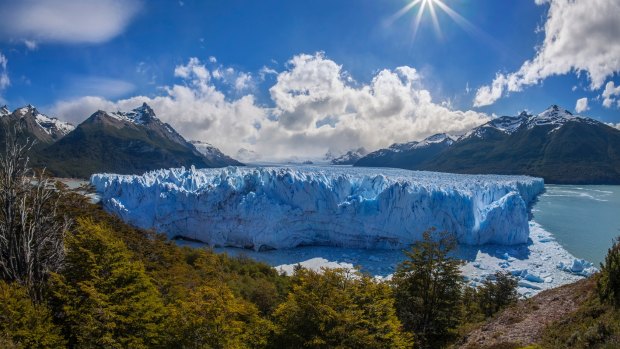This was published 7 years ago
Bucket list: The 10 places in the world that photos can't do justice, you need to see in real life
By David Whitley
Sometimes, iffy holiday photos aren't just down to the klutz behind the camera – there are some incredible places that are frustratingly difficult to capture in a snapshot. Such as…
Niagara Falls
You can sure get some pretty shots from a distance of the Canadian Falls as they power over the horseshoe-shaped cliff. But they don't look all that huge. And up-close shots are just a blurry mess of water with spray on the lens. But Niagara's not about the height – it's about the ferocity and the amount of water surging over at any given time. A frozen snapshot can't pick up the power and the pace.

The Perito Moreno Glacier, Argentina.Credit: iStock
See: Niagara - totes amaze falls
Versailles, France
Louis XIV's colossal ego-massage project is notable for its staggering size, but the main issue for photographers not armed with super wide-angle lenses or helicopters is that the façade is so darned long. That means up close, you only get a small portion of it, and without any clear edges. To get it all in, you have to be so far away that the whole exercise becomes pretty much pointless.
Tikal, Guatemala
Arguably the most impressive of all the Mayan sites, Tikal is basically a city full of giant monuments that have only partially been recovered from the jungle. And that jungle is part of the problem – despite being able to climb some of the ziggurat-style temples, there's no one point where you can get the whole city lined up for the money shot. You just get the tops of temple poking out over trees.
The other problem is the weather – it is almost always hot, sticky and overcast in Tikal, which makes the perfect blue sky image unlikely.
The Arabian Desert
That desert trip from Dubai or Abu Dhabi can provide some marvellous, vast horizons of seductive rolling sand dunes. But it's very difficult to capture the scale, and the camera has a tendency to flatten the differences in elevation due to the dunes looking so similar. Light is the key to getting halfway respectable shots – the first and last hour of daylight will provide more, much-needed shadow. And honing in rather than trying to capture it all is usually a better bet.
See also: Bleak, spectacular and deadly
Cape Point, South Africa
By all means take a picture of the endless ocean unfolding before you, but it's just going to look like interchangeable sea. What's important is behind you, not what's in front – and it's a similar case for almost all places with an end-of-the-earth feel. The sensation of being on the last bit of land usually dwarfs the visual impact of either said land or the sea ahead of it.
See also: The hidden gems of South Africa's 'Mother City'
The Leaning Tower of Pisa, Italy
It's very hard to get a good shot of the famous leaning tower, largely due to hordes of people in the way trying to get photos of themselves with it. But even if you can miraculously get everyone to clear off, chances are that the picture won't do the place justice. And that's because the cathedral itself is way, way more impressive than the tower, but everyone crops it out.
Dead Horse Point, Utah
The view from the top of Dead Horse Point is special. Canyons lie below it, breaking across the horizon in splintering waves. There's so much detail to take in with the landscape unfurling in deep chasms, and it's this detail the camera struggles to convey. Sure, you'll get a pretty superb shot from up there, but it'll come across as broad brush rather than a panorama of intricacies.
Ubirr, Kakadu National Park
The views from the top of Ubirr out over a vast flood plain make for cracking photographs. But the pics of the rock art galleries in the caves and under the overhangs on the way are not so simple. This is partly because images have been layered on top of each other over time, partly because time has faded the images and partly because the colours used are similar to the rock itself. They're hardly the works of a Rembrandt or Van Gogh either – just simple, story-telling symbols that are significant for their historical importance rather than artistic merit. So, generally, a bit of Photoshop work is going to be needed to make the main images stand out.
See: 20 reasons to visit Kakadu
Waitomo Caves, New Zealand
Whether on a boat or floating through on a rubber tube, the Waitomo Caves are at their most magical when it's dark. That's when the glowworms spring into life, lighting up the cave roof like a twinkling, starry sky. Trying to capture that is futile. Firstly, going for the camera will ruin the moment. Secondly, it's unlikely to come out as anything more than a load of indistinct white dots unless you're properly geared up with top equipment.
See also: Ten things you can only do in New Zealand
Perito Moreno Glacier, Argentina
It's a five-kilometre wide, 60-kilometre long and 70-metre high wall of ice that comes to an abrupt halt in a lake. But it's so immense that it's hard to convey in one shot without making it look far less significant than it is. It's also missing the sound. The cracking noises as the ice shifts are a large part of what makes it so intimidating.
See: Perito Moreno, the spectacular ice wall you need to see for yourself
See also: The top 17 countries to visit in 2017
Sign up for the Traveller Deals newsletter
Get exclusive travel deals delivered straight to your inbox. Sign up now.